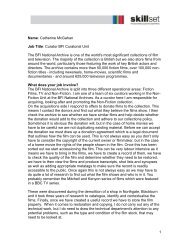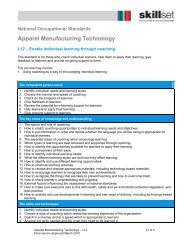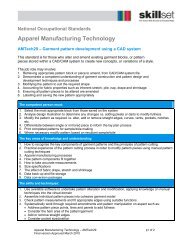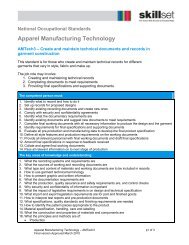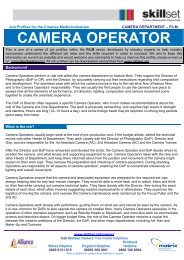Publishing in the Knowledge Economy - DTI Home Page
Publishing in the Knowledge Economy - DTI Home Page
Publishing in the Knowledge Economy - DTI Home Page
You also want an ePaper? Increase the reach of your titles
YUMPU automatically turns print PDFs into web optimized ePapers that Google loves.
The <strong>in</strong>dustry today<br />
<strong>Publish<strong>in</strong>g</strong> <strong>in</strong> <strong>the</strong> knowledge economy<br />
companies are unable to move quickly enough<br />
to respond to <strong>the</strong> opportunities and <strong>the</strong>refore<br />
<strong>in</strong>vest considerable time and money <strong>in</strong><br />
respond<strong>in</strong>g rapidly to new threats over which<br />
<strong>the</strong>y have little control. Focus is lost as<br />
competition comes from new entrants <strong>in</strong>to <strong>the</strong><br />
market and o<strong>the</strong>r media companies. Advertisers<br />
move spend<strong>in</strong>g to <strong>the</strong> media that can deliver <strong>the</strong><br />
best mix of broad and targeted audiences.<br />
14.3.3 Careful transition of bus<strong>in</strong>ess to <strong>the</strong><br />
knowledge economy<br />
The scenario assesses <strong>the</strong> advent of <strong>the</strong><br />
changed knowledge economy occurr<strong>in</strong>g at<br />
a pace that plays to <strong>the</strong> strengths of <strong>the</strong><br />
publish<strong>in</strong>g <strong>in</strong>dustry. The publishers have<br />
cont<strong>in</strong>ued to put <strong>in</strong> place processes, technology<br />
and bus<strong>in</strong>ess models which migrate <strong>the</strong>ir<br />
bus<strong>in</strong>esses to operat<strong>in</strong>g <strong>in</strong> a managed and<br />
measured transition from paper-based<br />
publish<strong>in</strong>g to digital media dom<strong>in</strong>ated<br />
publish<strong>in</strong>g. The publishers are <strong>the</strong>refore <strong>in</strong> a<br />
position to exploit fully <strong>the</strong> opportunities of <strong>the</strong><br />
new environment, assum<strong>in</strong>g that o<strong>the</strong>r<br />
regulatory and economic factors are favourable.<br />
Premise<br />
• Adoption of technology by <strong>the</strong> general public<br />
follows predicted trends<br />
• Bus<strong>in</strong>esses adapt <strong>the</strong>ir processes at a<br />
steady pace<br />
• Take up of new network services mirrors take<br />
up of Internet<br />
• Companies implement <strong>in</strong>tegrated publish<strong>in</strong>g<br />
technology systems <strong>in</strong>clud<strong>in</strong>g DRM, CMS<br />
and CRM<br />
• Companies migrate <strong>the</strong>ir paper-based<br />
bus<strong>in</strong>esses at a manageable pace to<br />
digital bus<strong>in</strong>esses<br />
• Strategic acquisitions, mergers and<br />
partnerships are made to offer <strong>the</strong> best<br />
products and services to end-customers and<br />
advertisers.<br />
Implications<br />
• <strong>Publish<strong>in</strong>g</strong> companies implement technologies<br />
to improve processes and reduce costs while<br />
prepar<strong>in</strong>g for <strong>the</strong> future<br />
• Pr<strong>in</strong>t revenues form <strong>the</strong> basis of publish<strong>in</strong>g<br />
company revenues for a good number of<br />
years<br />
• Investments are kept at reasonable levels<br />
• Mergers and acquisitions can be carried<br />
across media<br />
Outcome<br />
The publish<strong>in</strong>g <strong>in</strong>dustry is able to develop<br />
bus<strong>in</strong>ess models, implement technological<br />
changes and staff tra<strong>in</strong><strong>in</strong>g <strong>in</strong> a manner that can<br />
be supported by its exist<strong>in</strong>g bus<strong>in</strong>ess and move<br />
to streng<strong>the</strong>n fur<strong>the</strong>r <strong>the</strong> <strong>in</strong>dustry. The <strong>in</strong>dustry<br />
improves its competitive position and can react<br />
quickly to exploit new opportunities and ward<br />
off, as yet, unforeseen threats.<br />
14.4 Scenario conclusion<br />
The publish<strong>in</strong>g <strong>in</strong>dustry must prepare itself for<br />
life <strong>in</strong> a knowledge economy. The <strong>in</strong>dustry<br />
cannot directly <strong>in</strong>fluence <strong>the</strong> rate of change <strong>in</strong><br />
that environment, but it can take actions now<br />
to ensure it can migrate profitably to <strong>the</strong><br />
knowledge economy at <strong>the</strong> same time as<br />
protect<strong>in</strong>g itself from <strong>the</strong> effects of ei<strong>the</strong>r a<br />
recession and slow uptake or a dramatic<br />
<strong>in</strong>crease <strong>in</strong> <strong>the</strong> acceptance of <strong>the</strong> knowledge<br />
economy by both bus<strong>in</strong>ess and <strong>the</strong> public.<br />
Part 2 of <strong>the</strong> report will provide an analysis of<br />
<strong>the</strong> ma<strong>in</strong> issues affect<strong>in</strong>g future competitiveness<br />
and draw out <strong>the</strong> necessary action po<strong>in</strong>ts.<br />
85




